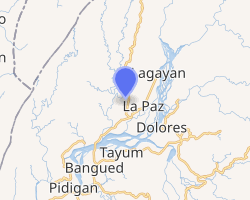Danglas
Danglas, officially the Municipality of Danglas (Ilocano: Ili ti Danglas; Tagalog: Bayan ng Danglas), is a 5th class municipality in the province of Abra, Philippines. According to the 2015 census, it has a population of 4,192 people.[3]
Danglas | |
|---|---|
| Municipality of Danglas | |
 Seal | |
 Map of Abra with Danglas highlighted | |
OpenStreetMap 
| |
.svg.png) Danglas Location within the Philippines | |
| Coordinates: 17°41′N 120°40′E | |
| Country | |
| Region | Cordillera Administrative Region (CAR) |
| Province | Abra |
| District | Lone District |
| Barangays | 7 (see Barangays) |
| Government | |
| • Type | Sangguniang Bayan |
| • Mayor | Denise Florence B. Bragas |
| • Vice Mayor | Esther B. Bernos |
| • Congressman | Joseph Santo Niño B. Bernos |
| • Electorate | 3,231 voters (2019) |
| Area | |
| • Total | 156.02 km2 (60.24 sq mi) |
| Population (2015 census)[3] | |
| • Total | 4,192 |
| • Density | 27/km2 (70/sq mi) |
| • Households | 873 |
| Economy | |
| • Income class | 5th municipal income class |
| • Poverty incidence | 21.44% (2015)[4] |
| • Revenue (₱) | 59,173,704.57 (2016) |
| Time zone | UTC+8 (PST) |
| ZIP code | 2825 |
| PSGC | |
| IDD : area code | +63 (0)74 |
| Climate type | tropical rainforest climate |
| Native languages | Itneg language Ilocano Tagalog |
Geography
According to the Philippine Statistics Authority, the municipality has a land area of 156.02 square kilometres (60.24 sq mi) [2] constituting 3.75% of the 4,165.25-square-kilometre- (1,608.21 sq mi) total area of Abra.
Climate
| Climate data for Danglas, Abra | |||||||||||||
|---|---|---|---|---|---|---|---|---|---|---|---|---|---|
| Month | Jan | Feb | Mar | Apr | May | Jun | Jul | Aug | Sep | Oct | Nov | Dec | Year |
| Average high °C (°F) | 29 (84) |
30 (86) |
32 (90) |
33 (91) |
32 (90) |
31 (88) |
30 (86) |
29 (84) |
30 (86) |
30 (86) |
30 (86) |
29 (84) |
30 (87) |
| Average low °C (°F) | 18 (64) |
19 (66) |
20 (68) |
22 (72) |
24 (75) |
24 (75) |
24 (75) |
24 (75) |
23 (73) |
22 (72) |
20 (68) |
19 (66) |
22 (71) |
| Average precipitation mm (inches) | 9 (0.4) |
11 (0.4) |
13 (0.5) |
23 (0.9) |
92 (3.6) |
122 (4.8) |
153 (6.0) |
137 (5.4) |
139 (5.5) |
141 (5.6) |
42 (1.7) |
14 (0.6) |
896 (35.4) |
| Average rainy days | 4.6 | 4.0 | 6.2 | 9.1 | 19.5 | 23.2 | 24.0 | 22.5 | 21.5 | 15.2 | 10.5 | 6.0 | 166.3 |
| Source: Meteoblue (modeled/calculated data, not measured locally) [5] | |||||||||||||
Barangays
Danglas is politically subdivided into 7 barangays.[6]
| PSGC | Barangay | Population | ±% p.a. | |||
|---|---|---|---|---|---|---|
| 2015[3] | 2010[7] | |||||
| 140106001 | Abaquid | 6.6% | 275 | 423 | −7.87% | |
| 140106003 | Cabaruan | 16.1% | 673 | 650 | 0.66% | |
| 140106004 | Caupasan (Poblacion) | 32.4% | 1,359 | 1,398 | −0.54% | |
| 140106005 | Danglas | 8.5% | 357 | 479 | −5.44% | |
| 140106006 | Nagaparan | 19.2% | 803 | 819 | −0.37% | |
| 140106007 | Padangitan | 9.9% | 417 | 502 | −3.47% | |
| 140106008 | Pangal | 7.3% | 308 | 463 | −7.47% | |
| Total | 4,192 | 4,734 | −2.29% | |||
Demographics
|
| |||||||||||||||||||||||||||||||||||||||||||||
| Source: Philippine Statistics Authority[3][7][8][9] | ||||||||||||||||||||||||||||||||||||||||||||||
In the 2015 census, Danglas had a population of 4,192.[3] The population density was 27 inhabitants per square kilometre (70/sq mi).
Economy
The economy of the municipality is heavily dependent on agriculture particularly palay, corn, vegetables and fruits. Other raw materials include rattan and bamboos.
References
- "Municipality". Quezon City, Philippines: Department of the Interior and Local Government. Retrieved 31 May 2013.
- "Province: Abra". PSGC Interactive. Quezon City, Philippines: Philippine Statistics Authority. Retrieved 12 November 2016.
- Census of Population (2015). "Cordillera Administrative Region (CAR)". Total Population by Province, City, Municipality and Barangay. PSA. Retrieved 20 June 2016.
- "PSA releases the 2015 Municipal and City Level Poverty Estimates". Quezon City, Philippines. Retrieved 12 October 2019.
- "Danglas: Average Temperatures and Rainfall". Meteoblue. Retrieved 25 April 2020.
- "Municipal: Danglas". PSGC Interactive. Quezon City, Philippines: Philippine Statistics Authority. Retrieved 8 January 2016.
- Census of Population and Housing (2010). "Cordillera Administrative Region (CAR)". Total Population by Province, City, Municipality and Barangay. NSO. Retrieved 29 June 2016.
- Censuses of Population (1903–2007). "Cordillera Administrative Region (CAR)". Table 1. Population Enumerated in Various Censuses by Province/Highly Urbanized City: 1903 to 2007. NSO.
- "Province of Abra". Municipality Population Data. Local Water Utilities Administration Research Division. Retrieved 17 December 2016.
External links

- Danglas Profile at PhilAtlas.com
- Philippine Standard Geographic Code